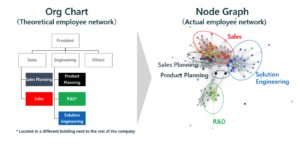The Background
A large business unit at a major, multinational technology company headquartered in Japan had recently come under new leadership. Faced with stricter government regulation to improve employee work-life balance to prevent “death by overwork” and ever-increasing pressure from shareholders to increase profits, the new department CEO knew he had to take a different approach to sustainably balance both employee engagement and productivity. The department was also in the process of building out a new headquarter office, so there was even more time-pressure to make choices about how to assign physical office space to teams in a way that would optimize the department’s overall health.
The CEO had some radical ideas for ways he could improve culture and utilize different workspaces, but knew he needed to validate his assumptions and build employee trust using data to ensure employee buy-in and that his changes would have the intended impacts. To do this, he decided to engage Humanyze to quantitatively measure the department’s collaboration and work behaviors, starting with a high-priority focus on teams most connected to the department’s revenue.
The Challenge
Despite its notoriously workplace culture of long working hours that leads to burnout and (in some extreme cases) death, a strongly-held belief remains within many Japanese companies that long working hours mean higher levels of productivity and performance. In this particular organization’s revenue-generating business units, many sales managers strongly believed that longer working hours correlated directly to increased sales. As a result, it was essential for the company to address this with a data-backed approach of mitigating burnout and reducing working hours without hindering employee productivity or performance reviews.
The Approach
Humanyze worked with the company’s IT, HR, and real estate functions to combine and analyze multiple sources of anonymized, corporate-owned data, including metadata from email, calendar, and chat tools (as well as office access card data) over a 4-week period across dozens of sales, engineering, and support teams. This combination of data sources allowed Humanyze to assess both virtual and approximated in-person interactions within and across teams using its full suite of behavioral workplace metrics and a focus on the following two questions:
- How can we be more productive without sacrificing the health and happiness of our people?
- What behaviors lead to success in our department?
To evaluate whether certain behaviors led to higher sales performance, Humanyze also conducted a statistical analysis across the sales teams to determine if any behavioral metrics had a positive or negative correlation with deal outcomes. This additional lens would augment and enhance existing forms of measurement, such as sales KPIs and employee survey responses, in order to provide a holistic view of what actually improves sales and increase revenue.
The CEO hoped that measuring behavioral workplace metrics could help fill in gaps in knowledge and solve the puzzle of how to optimize both productivity and employee wellbeing.
Initial Findings
Out of dozens of metrics, the analysis revealed that only certain types of collaboration had a significant influence on performance, while other behaviors that could lead to overwork and burnout did not.

Statistical Analysis of High Performing Salespeople’s Behaviors Against Humanyze Metrics
1. Collaboration between Sales & Solution Engineers Boosts Sales Performance
At the time of analysis, Sales and Engineering formally sat on separate teams. Analysis of face-to-face and digital collaboration revealed, however, that sales people who regularly interact with sales engineers while at the office, were much more likely to perform better. Though digital/virtual collaboration did not negatively impact performance, this connection was only statistically significant when the two teams interact in-person.

Organizational Structure vs. Actual Collaboration That’s Happening
2. Extended, Inefficient Working Hours Decrease Performance
While collaboration with Sales Engineers led to increases in performance, sales people who worked extended hours (over 10 hours per day, on average) were significantly less likely to perform well. These lower-performing sales people also had higher levels of “Transition Time,” which is a metric that measures the average amount of time in a day that is “wasted” mentally transitioning from one interaction to another task. High levels of transition time can indicate that employees do not manage their time efficiently, which can lead to longer days.
The Takeaways
The CEO’s ability to prove with data that working overtime does not correlate with better performance helped to quantitatively make the case that unhealthy working behaviors were actually counter-productive for the organization. This served as a powerful tool for getting middle management’s buy-in to reduce overtime on their teams and to consider other interventions that could actually improve performance.
Following the initial analysis, the CEO circulated the insights to all employees, so each person could benefit from the data and take action on their own to improve their performance and protect their work-life balance. This helped lay the groundwork for other changes he made to support the department’s health, including re-organizing the department to formally encourage interaction between Sales and Solution Engineering and re-stacking seating assignments in the new headquarters to increase face-to-face interaction.
Importantly, the organization’s work with Humanyze did not stop at the first analysis. They leverage Humanyze on an ongoing basis in order to continuously identify and address causes of inefficiency or areas for improvement as they make changes and adjust behaviors over time. Using Humanyze’s ongoing behavioral workplace insights, the customer has been able to inform better, data-driven human capital and workplace strategy decisions that retain a healthy, high-performing workforce in the midst of COVID-19 and beyond.

